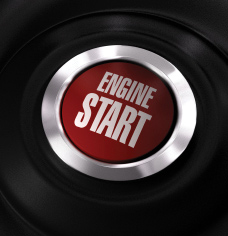The Car Care Council 
POTHOLES PACK A POWERFUL PUNCH
Winter is pothole season and this year they are packing a powerful punch. After hitting a pothole most drivers wonder, “Is my car OK?” While the tires and wheels can be visually inspected, there could be damage to the steering, suspension and alignment systems that you just can’t see. To help determine if hitting a pothole has damaged your vehicle watch for the following warning signs provided by the Car Care Council.
- Loss of control, swaying when making routine turns, bottoming out on city streets or bouncing excessively on rough roads. These are indicators that the steering and suspension may have been damaged. The steering and suspension are key safety related systems. Together, they largely determine your car’s ride and handling. Key components are shocks and/or struts, the steering knuckle, ball joints, the steering rack/box, bearings, seals and hub units and tie rod ends.
- Pulling in one direction, instead of maintaining a straight path, and uneven tire wear. These symptoms mean there’s an alignment problem. Proper wheel alignment is important for the life span of tires and helps ensure safe handling.
- Low tire pressure, bulges or blisters on the sidewalls, or dents in the rim. These problems will be visible and should be checked out as soon as possible as tires are the critical connection between your car and the road in all sorts of driving conditions.
“Snow, cold temperatures and rainfall can lead to potholes and, with the wintry weather that has covered most of the country this year, navigating the streets could be difficult,” said Rich White, executive director, Car Care Council.
“If you’ve hit a pothole and suspect that there may be damage to the tires, wheels, steering and suspension or wheel alignment, it’s worth having a professional technician check out the car and make any necessary repairs.”
As a general rule of thumb, steering and suspension systems should be checked at least once a year and wheels should be aligned at the same interval. Motorists who live in areas where potholes are common should be prepared to have these systems checked more frequently.
Potholes occur during the winter and spring months when water permeates the pavement, usually through a crack from wear and tear of traffic, and softens the soil beneath it creating a depression in the surface of the street. Many potholes appear during winter and spring months because of freeze thaw cycles which accelerate the process. Potholes can also be prevalent in areas with excessive rainfall and flooding.

 |
LADIES AND GENTLEMEN, START YOUR ENGINES
The beginning of racing season is the perfect time of the year to “start your engine” and make sure your ignition system is working properly. Addressing problems that may lead to ignition system failure is essential for dependable vehicle operation so you won’t be left stranded at the starting line, says the Car Care Council.
“Many systems on your car work together to keep you on the go, and the most important is the ignition system,” said Rich White, executive director, Car Care Council. “Symptoms of ignition problems include dimming of headlights and interior lights, illuminated ‘Check Engine’ and/or battery lights and failure of accessories to operate. It’s a good idea to look into these symptoms immediately to prevent ignition failure from bringing your car to a complete stop.” |
Driving habits such as frequent engine on/off cycles cause more wear on the starter than a simple trip back and forth to work. Other factors, including driving and weather conditions, mileage, vehicle age and excessive electrical draws like in-vehicle entertainment systems, can impact the ignition system as well. Since the fuel injection system and car battery are linked to the ignition system, a problem can be difficult to diagnose because it may be caused by one of many factors, such as a dead car battery, faulty ignition switch, worn out spark plugs, bad fuel injectors, ignition coil problems, fuel pump failure or starter motor failure.
“It’s a good idea to include an ignition system check-up to your vehicle maintenance schedule,” said White. “Having your ignition system checked regularly will ensure that you always reach the finish line.”
To help motorists follow a vehicle maintenance program, a free digital Car Care Guide can be found on the council’s website at www.carcare.org/car-care-guide. The guide is available in English and Spanish, and includes information on service interval schedules, questions to ask a technician and tips to drive smart and save money.
© 2013 TLC Magazine Online, Inc. |